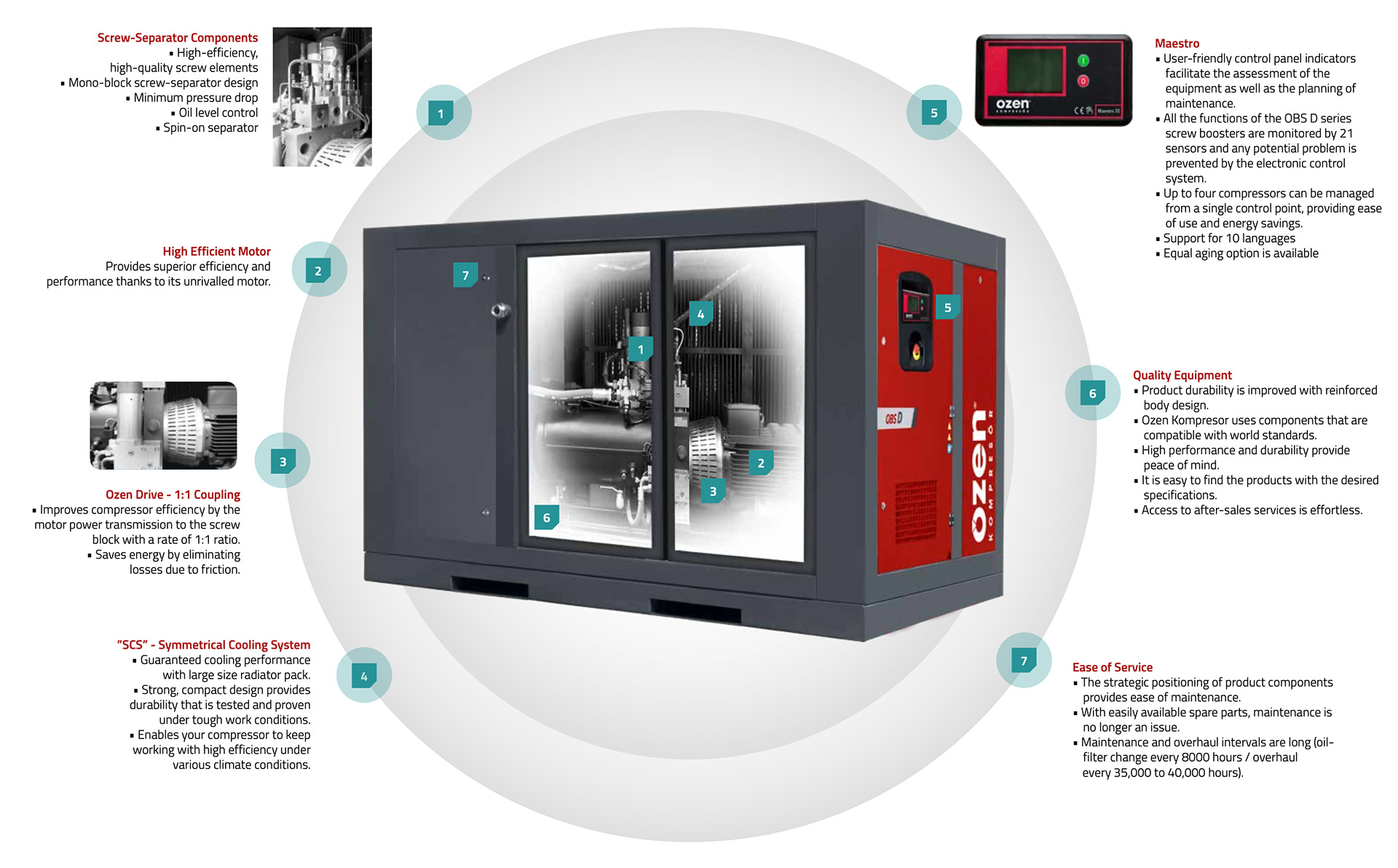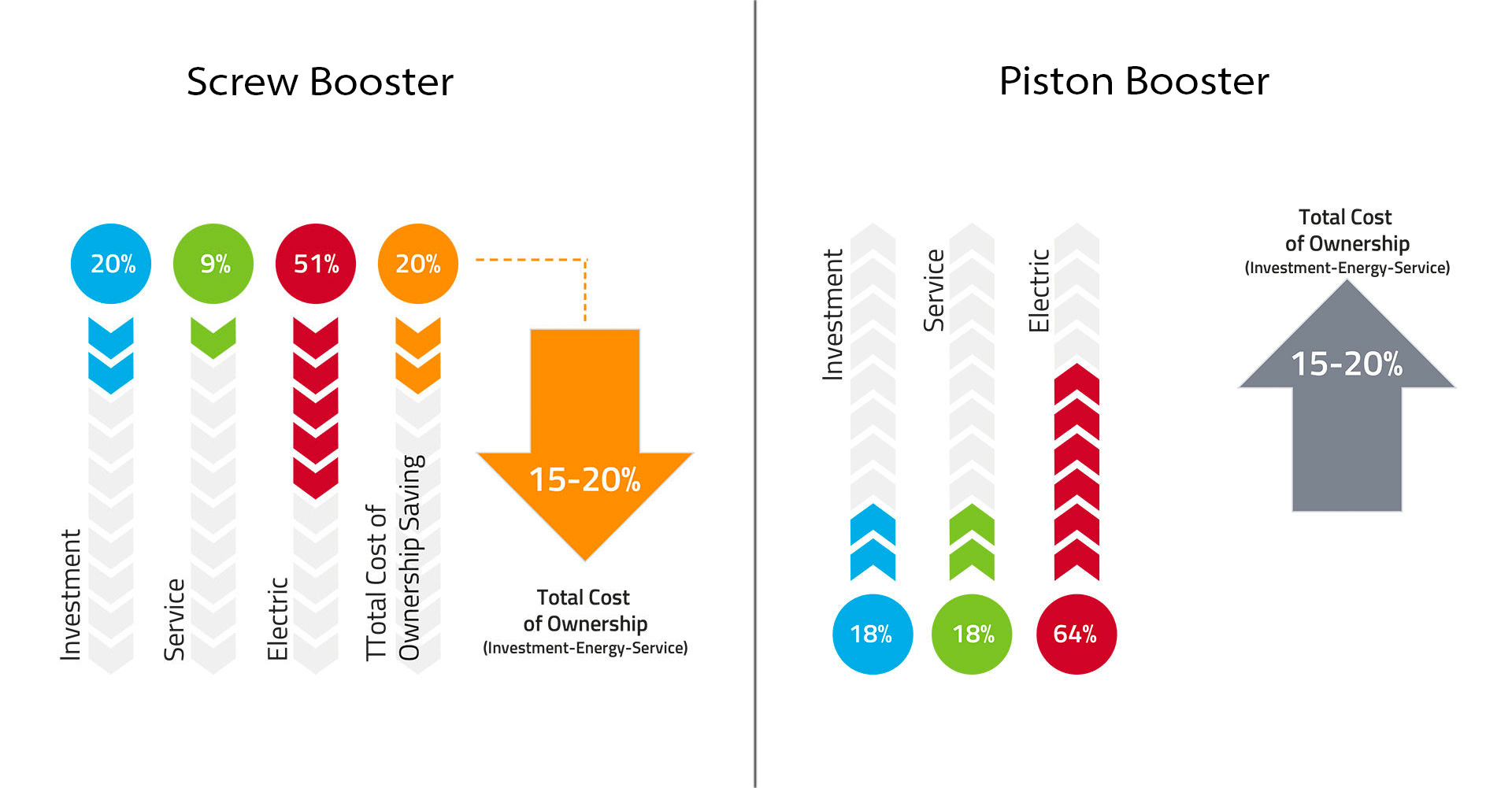Screw Booster Compressors
2 March 2023, Thursday

Screw boosters are compressors that increase the air pressure from an existing compression system by passing it through additional compression stages. Screw booster compressor differs from other compressors with its operating logic and compression ratio. Screw booster compressor has certain equipment that allows it to compress in addition to normal compressors. With the help of these equipment, the air entering the interior is reached to the maximum compression ratio. To give an example, a screw booster can compress air between 7 bar and 10 bar up to 5 times and reach a pressure between 35 bar and 40 bar.
Screw booster compressors are used in various industrial plants such as chemical treatment plants, wood and glass industry, power plants, metal processing and plastics industry.

What is the Working Logic of Screw Booster Compressors?
Working logic of screw booster compressors is slightly different than other compressors. Screw booster compressors operate in a closed system and have a simple operation logic such as increasing the pressure as the air volume in the system decreases. In normal compressors, the compressed air is compressed with the same pressure, even if its volume decreases. It is precisely at this point that the maximum compression ratio decreases. However, this is different in screw booster compressors. As air is compressed and its volume decreases, it is compressed even more. That is, as the air is compressed, the pressure is increased and it is compressed even more.
A booster air compressor operate on the simple principle that as the volume decreases in a closed system (non-vacuum), the pressure increases. Compression process is carried out with a system consisting of a receiver tank, piping and discharge tank. First, air is taken from the atmosphere to the receiving air tank. The air taken through the receiver tank comes from the primary supply in a compressed form. However, the air receiver tank contributes to maximum compression by passing air through certain compression steps within itself. The air receiver tank has another very important task in screw booster compressors. This task is to store a certain amount of air in the air system when it does not play an active role, that is, when the system is not operating. In other words, the receiver tank takes part in the storage in screw booster compressors.
The air, which has undergone a certain compression process by the receiving tank, is sent to the piping. The piping is responsible for transmitting the compressed air to further through the system. Compressed air from the receiving tank is transferred to the discharge tank through the piping system. The air transferred to the discharge tank undergoes compression processes and is ready to be exhausted. However, before the air is exhausted, it passes through dryers with high pressure. These dryers ensure the separation of moisture and water in the air. In other words, the point where the air quality increases is the drying process after the discharge tank. The air passing through the drying process is exhausted to be used at the exit point.
What is the Difference Between Screw Booster Compressor and Reciprocating Booster Compressor?

Booster compressors are also divided based on their working logic. The most common question is what kind of differences screw booster compressors offer compared to reciprocating booster compressors. If you are thinking of switching from a reciprocating booster compressor to a screw booster compressor or if you do not know which booster compressor to purchase, you can easily decide by taking these differences into consideration.
The reciprocating booster compressor cannot meet the needs of continuous and heavy-duty industries. While there is no power loss in the screw booster compressor system, there is power loss in the reciprocating booster compressors. In applications where very high compression is required, you cannot achieve the desired compression ratio due to this energy loss.
Reciprocating booster compressors cause higher electricity consumption due to their load and idle working principles. Thanks to the frequency inverter in the screw booster compressor, it consumes 10-15 percent less electricity. One of the biggest problems encountered in reciprocating booster compressors is the oil transfer problem. Oil transfer rate in reciprocating booster compressors is very high and can adversely affect air quality. However, oil transfer rate is almost zero in screw booster compressors.
Due to the high maintenance frequency in reciprocating booster compressors, maintenance costs are high. Due to the high maintenance frequency in reciprocating booster compressors, they provide an advantage in terms of total cost of ownership with their long service and maintenance intervals.
You too can contribute to the efficiency of your industrial enterprise by choosing a screw booster compressor. You can call us for more information about Özen Compressor OBS D screw booster compressor series.
